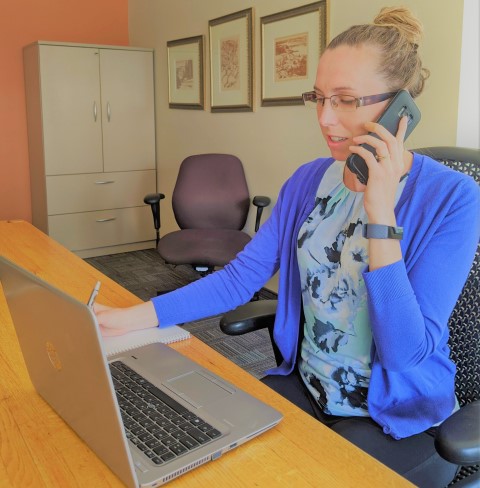By Crystal Gonder
The COVID-19 pandemic has forced all parts of the health care system to rethink the way they deliver care and at VHA Home HealthCare, the more than 10,000 virtual visits completed by our service providers since April, have proven that crisis really is a powerful catalyst.
Although virtual care, sometimes called teletherapy or digital health, existed before the pandemic and the technology isn’t new, barriers including confidentiality, compensation and access have always kept these services from being widely used. However, the physical distancing and stay-at-home orders enforced by COVID-19 created an urgent need to provide care whenever possible, without being face-to-face.
It is entirely new for home care, which primarily delivers care in the intimacy of a client’s home, to try to replicate that same type of connection and the same level of clinical effectiveness, through virtual means. This digital revolution that is happening on an accelerated timeline, is being seen as a silver lining in what has been a scary and challenging time.
“VHA was aware of the benefits of virtual care and it was part of our strategic plan for 2020-25 to implement the technology and changes to clinical practices to support this. COVID-19 triggered an immediate necessity and we fast-tracked the work to move it forward within a few weeks,” says Kathy McKenna, Electronic Medical Records Initiative (EMRI) Project Lead at VHA Home HealthCare.“We started with our Rehab Division—physiotherapists, occupational therapists (OTs), speech language pathologists, dietitians and social workers. Virtual care has allowed these front-line service providers to connect safely and effectively with clients and families at a distance, whenever clinically appropriate,” says Kathy. Although in-person visits are still essential for clients with certain equipment needs, serious feeding challenges, hospital pre-discharge visits and other critical services, virtual care has been implemented for many of our clients and families on a case-by-case basis.
For clinicians like Sharon Rosenthal, an OT and Paediatric Clinical Lead, initially there were a lot of doubts around how to have worthwhile, successful sessions that would benefit her clients without a traditional therapeutic connection.
“At first, the technology made me quite anxious and overwhelmed—where to put my camera, how my clients would navigate their own devices—and all my sessions were planned down the to the nth degree,” Sharon says. “But already things look and feel much better. I’m more at ease, the connection is surprisingly natural, engagement is good and I’ve built meaningful relationships with my clients.”
“To be honest, when I started seeing my clients again in their homes remotely, it was when I started to feel joy again,” says Sharon. “It’s been such a challenge to be quarantined in my home, unsure of how to do my job. I see many young families and thanks to the ability to hold virtual visits, I recently watched one of the babies I work with learning to walk. I was in tears.”
Of course, as with any new technology, there have been connection, sound and other technological issues along the way. “I did an entire session sideways, after a client couldn’t change the orientation on their screen. So, I spent a session with my head tilted,” Sharon laughed. “I would say though that overall, these types of problems haven’t been common.”
Brydne Edwards, OT and Professional Practice Specialist and Educator at VHA notes that for virtual care to work, there has to be an entire cultural shift. “Before COVID-19, in-person service was always perceived as the gold standard. For this to be successful, we definitely need to broaden our view of what it means to deliver care,” she says.
Service providers have developed a lot of creative ways to offer high-quality care even though they are not face-to-face with their clients. “Some of our clinicians have been making their own videos, demonstrating exercises or activities with items around their homes and utilizing helpful online resources. It has been really interesting to see how effective these strategies are,” says Brydne. “Surprisingly, we’ve also found that in many cases it’s been easier to build relationships virtually, rather than when our clinicians go into homes wearing full protective equipment, which can make communicating empathy and other emotions more challenging,” she says.
“There have been some difficulties to address, such as creating clear documentation guidelines, establishing robust consent processes, clients’ access and understanding of technology, as well as navigating different standards for each professional college,” says Brydne. “But what our teams have been able to do very quickly has been remarkable.”
The next phase of VHA’s shift to virtual care will focus on palliative and adult nursing and
Community Support Programs and is expected to be rolled out later this month. “I don’t think this is going away. Virtual health is here to stay, there’s no going back to business as usual and the health care system has undoubtedly changed,” says Sharon Rosenthal. “As schools, cities, the country and the world open up more, a hybrid of services will meet the needs of our community and open up care for areas that are not well-served and in situations where in-person visits are not possible.”
Crystal Gonder is a Communications Consultant at VHA Home HealthCare.


